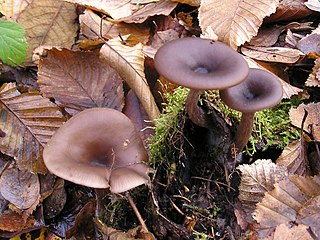
Puffballs are fungi, so named because clouds of brown dust-like spores are emitted when the mature fruitbody bursts or is impacted. Puffballs are in the division Basidiomycota and encompass several genera, including Calvatia, Calbovista and Lycoperdon. True puffballs do not have a visible stalk or stem. The puffballs were previously treated as a taxonomic group called the Gasteromycetes or Gasteromycetidae, but they are now known to be a polyphyletic assemblage.

The great blue turaco is a bird species of the family Musophagidae. At 70–76 cm (28–30 in) in length, it is the largest species of turaco. It has predominantly grey-blue plumage with an upright blue-black crest around 10 cm (3.9 in) high. The male and female have similar plumage. It is widespread throughout the African tropical rainforest.

Olacaceae is a family of flowering plants in the order Santalales. They are woody plants, native throughout the tropical regions of the world. As of July 2021, the circumscription of the family varies; some sources maintain a broad family, others split it into seven segregate families.
The Cypriot mouse is a species of mouse endemic to Cyprus. Its primary habitat seems to be the vineyards and fields of the Troödos Mountains region.

Kemp's gerbil is a species of rodent. Mammal Species of the World considers G. kempi and G. gambianus to be synonyms, however the IUCN has assessed each taxon as were they different species.
Eschweilera cyathiformis is a species of woody plant in the family Lecythidaceae. It is found only in Brazil. It is threatened by habitat loss.

The gracile naked-tailed shrew is a species of mammal in the family Soricidae. It is found in Burundi, Gabon, Kenya, and Uganda. Its natural habitat is swamps.
Heisteria asplundii is a species of plant in the family Olacaceae. It is endemic to Ecuador.

Heisteria is a genus of plants in the family Olacaceae. It contains the following species :
Heisteria maguirei is a species of plant in the family Olacaceae. It is found in Brazil, Guyana, and Venezuela.

Helicia is a genus of 110 species of trees and shrubs, constituting part of the plant family Proteaceae. They grow naturally in rainforests throughout tropical South and Southeast Asia, including India, Sri Lanka, Indochina, Peninsular Malaysia to New Guinea and as far south as New South Wales.
As of July 2016, the International Union for Conservation of Nature (IUCN) lists 238 conservation dependent species. 0.29% of all evaluated species are listed as conservation dependent. The IUCN also lists seven subspecies and five varieties as conservation dependent.

The World's 25 Most Endangered Primates is a list of highly endangered primate species selected and published by the International Union for Conservation of Nature (IUCN) Species Survival Commission (SSC) Primate Specialist Group (PSG), the International Primatological Society (IPS), Global Wildlife Conservation (GWC), and Bristol Zoological Society (BZS). The IUCN/SSC PSG worked with Conservation International (CI) to start the list in 2000, but in 2002, during the 19th Congress of the International Primatological Society, primatologists reviewed and debated the list, resulting in the 2002–2004 revision and the endorsement of the IPS. The publication was a joint project between the three conservation organizations until the 2012–2014 list when BZS was added as a publisher. The 2018–2020 list was the first time Conservation International was not among the publishers, replaced instead by GWC. The list has been revised every two years following the biannual Congress of the IPS. Starting with the 2004–2006 report, the title changed to "Primates in Peril: The World's 25 Most Endangered Primates". That same year, the list began to provide information about each species, including their conservation status and the threats they face in the wild. The species text is written in collaboration with experts from the field, with 60 people contributing to the 2006–2008 report and 85 people contributing to the 2008–2010 report. The 2004–2006 and 2006–2008 reports were published in the IUCN/SSC PSG journal Primate Conservation,, since then they have been published as independent publications.

Pseudoclitocybe cyathiformis, commonly known as the goblet funnel cap, is a species of fungus in the family Tricholomataceae, and the type species of the genus Pseudoclitocybe. It was first described scientifically as Agaricus cyathiformis by Jean Baptiste François Pierre Bulliard in 1786, and later transferred to the genus Pseudoclitocybe by Rolf Singer in 1956. The fungus is found in North America and Europe.
Heisteria pallida is a plant species in the genus Heisteria found in Brazil.

Turbinaria is a genus of colonial stony corals in the family Dendrophylliidae. Common names for this genus include disc coral, scroll coral, cup coral, vase coral, pagoda coral and ruffled ridge coral. These corals are native to the Red Sea, Indian Ocean, Japan and the south Central Pacific Ocean.










